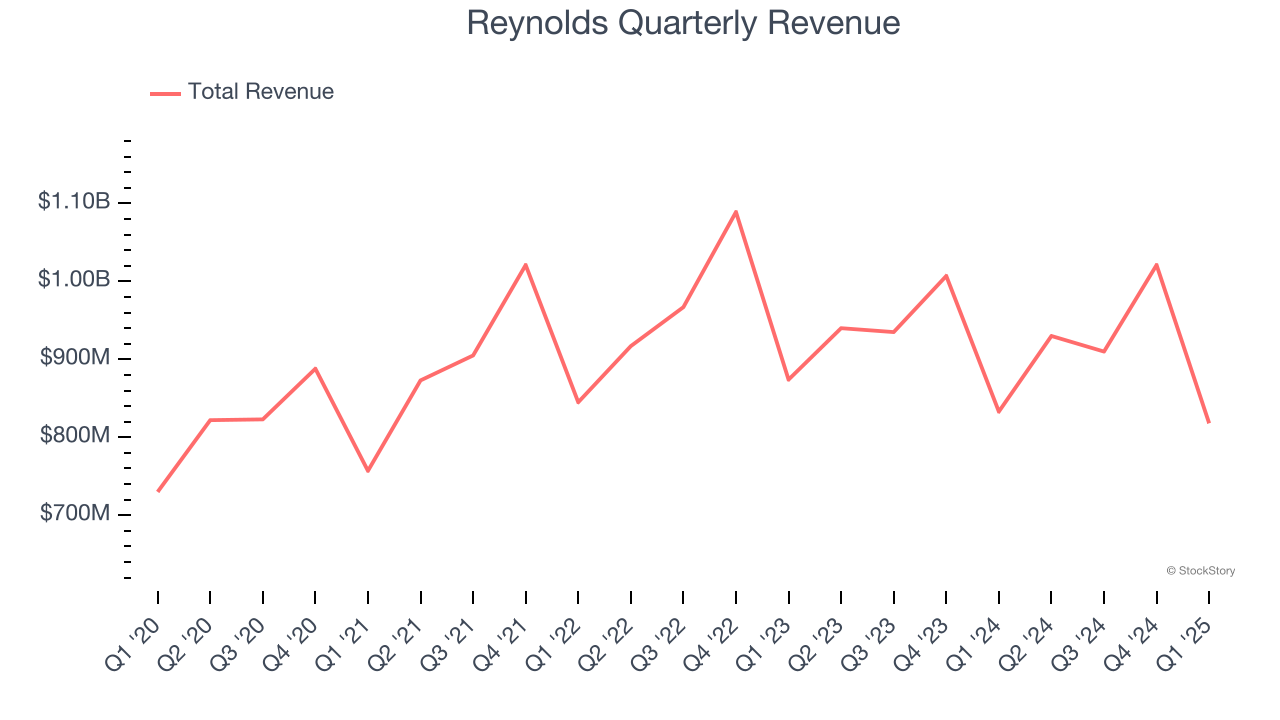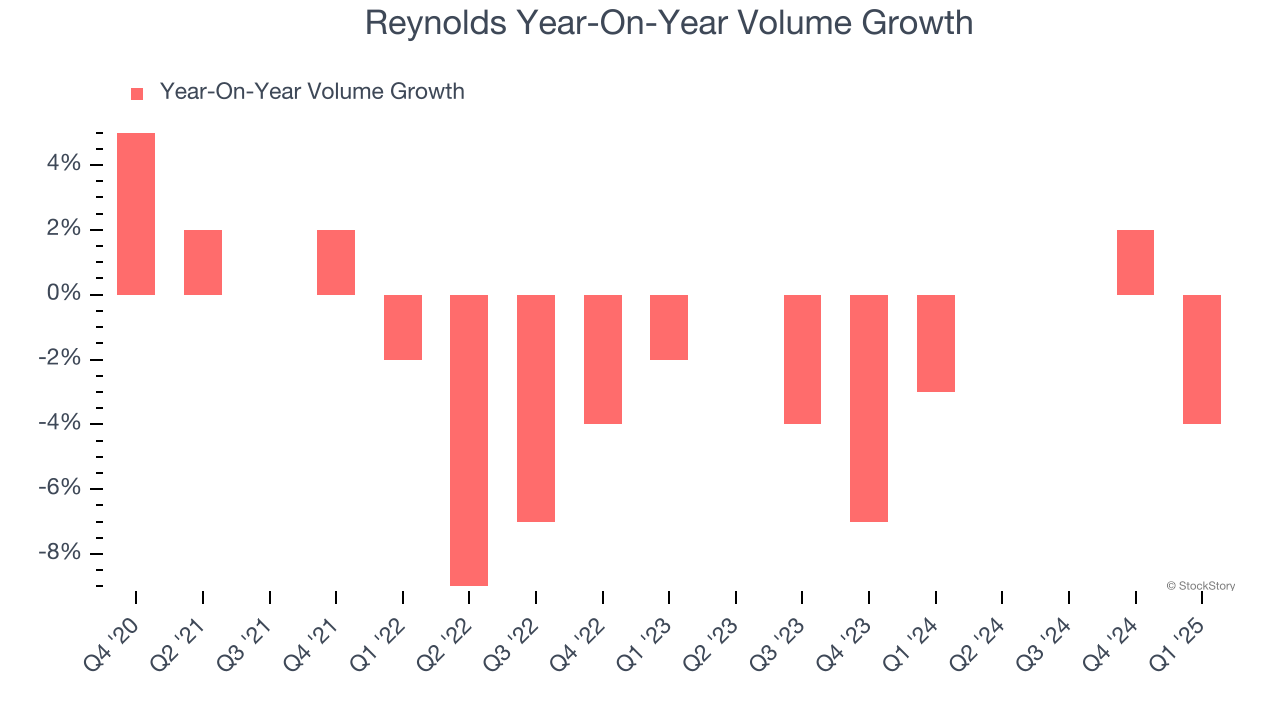
Household products company Reynolds (NASDAQ: REYN) met Wall Street’s revenue expectations in Q1 CY2025, but sales fell by 1.8% year on year to $818 million. On the other hand, next quarter’s revenue guidance of $897.5 million was less impressive, coming in 2.2% below analysts’ estimates. Its non-GAAP profit of $0.23 per share was in line with analysts’ consensus estimates.
Is now the time to buy Reynolds? Find out by accessing our full research report, it’s free.
Reynolds (REYN) Q1 CY2025 Highlights:
- Revenue: $818 million vs analyst estimates of $820.3 million (1.8% year-on-year decline, in line)
- Adjusted EPS: $0.23 vs analyst estimates of $0.23 (in line)
- Adjusted EBITDA: $117 million vs analyst estimates of $119.4 million (14.3% margin, 2% miss)
- Revenue Guidance for Q2 CY2025 is $897.5 million at the midpoint, below analyst estimates of $918.1 million
- Management lowered its full-year Adjusted EPS guidance to $1.58 at the midpoint, a 4.3% decrease
- EBITDA guidance for the full year is $660 million at the midpoint, below analyst estimates of $667.6 million
- Operating Margin: 9.3%, down from 10.8% in the same quarter last year
- Free Cash Flow Margin: 2.1%, down from 8.4% in the same quarter last year
- Organic Revenue fell 2% year on year (-5% in the same quarter last year)
- Sales Volumes fell 4% year on year (-3% in the same quarter last year)
- Market Capitalization: $4.98 billion
“We are executing well in a dynamic consumer and retail environment, outperforming our categories by two points in the quarter,” said Scott Huckins, President and Chief Executive Officer.
Company Overview
Best known for its aluminum foil, Reynolds (NASDAQ: REYN) is a household products company whose products focus on food storage, cooking, and waste.
Sales Growth
Reviewing a company’s long-term sales performance reveals insights into its quality. Any business can have short-term success, but a top-tier one grows for years.
With $3.68 billion in revenue over the past 12 months, Reynolds carries some recognizable products but is a mid-sized consumer staples company. Its size could bring disadvantages compared to larger competitors benefiting from better brand awareness and economies of scale.
As you can see below, Reynolds struggled to increase demand as its $3.68 billion of sales for the trailing 12 months was close to its revenue three years ago. This is mainly because consumers bought less of its products - we’ll explore what this means in the "Volume Growth" section.

This quarter, Reynolds reported a rather uninspiring 1.8% year-on-year revenue decline to $818 million of revenue, in line with Wall Street’s estimates. Company management is currently guiding for a 3.5% year-on-year decline in sales next quarter.
Looking further ahead, sell-side analysts expect revenue to remain flat over the next 12 months. This projection is underwhelming and suggests its newer products will not lead to better top-line performance yet.
Unless you’ve been living under a rock, it should be obvious by now that generative AI is going to have a huge impact on how large corporations do business. While Nvidia and AMD are trading close to all-time highs, we prefer a lesser-known (but still profitable) stock benefiting from the rise of AI. Click here to access our free report one of our favorites growth stories.
Volume Growth
Revenue growth can be broken down into changes in price and volume (the number of units sold). While both are important, volume is the lifeblood of a successful staples business as there’s a ceiling to what consumers will pay for everyday goods; they can always trade down to non-branded products if the branded versions are too expensive.
To analyze whether Reynolds generated its growth (or lack thereof) from changes in price or volume, we can compare its volume growth to its organic revenue growth, which excludes non-fundamental impacts on company financials like mergers and currency fluctuations.
Over the last two years, Reynolds’s average quarterly volumes have shrunk by 2%. This isn’t ideal for a consumer staples company, where demand is typically stable. In the context of its 2.3% average organic sales declines, we can see that most of the company’s losses have come from fewer customers purchasing its products.

In Reynolds’s Q1 2025, sales volumes dropped 4% year on year. This result represents a further deceleration from its historical levels, showing the business is struggling to move its products.
Key Takeaways from Reynolds’s Q1 Results
We struggled to find many positives in these results. Its gross margin missed and its EBITDA fell short of Wall Street’s estimates. Full-year EBITDA guidance missed, and full-year EPS was lowered. Overall, this was a softer quarter. The stock remained flat at $23.70 immediately following the results.
Reynolds may have had a tough quarter, but does that actually create an opportunity to invest right now? When making that decision, it’s important to consider its valuation, business qualities, as well as what has happened in the latest quarter. We cover that in our actionable full research report which you can read here, it’s free.







